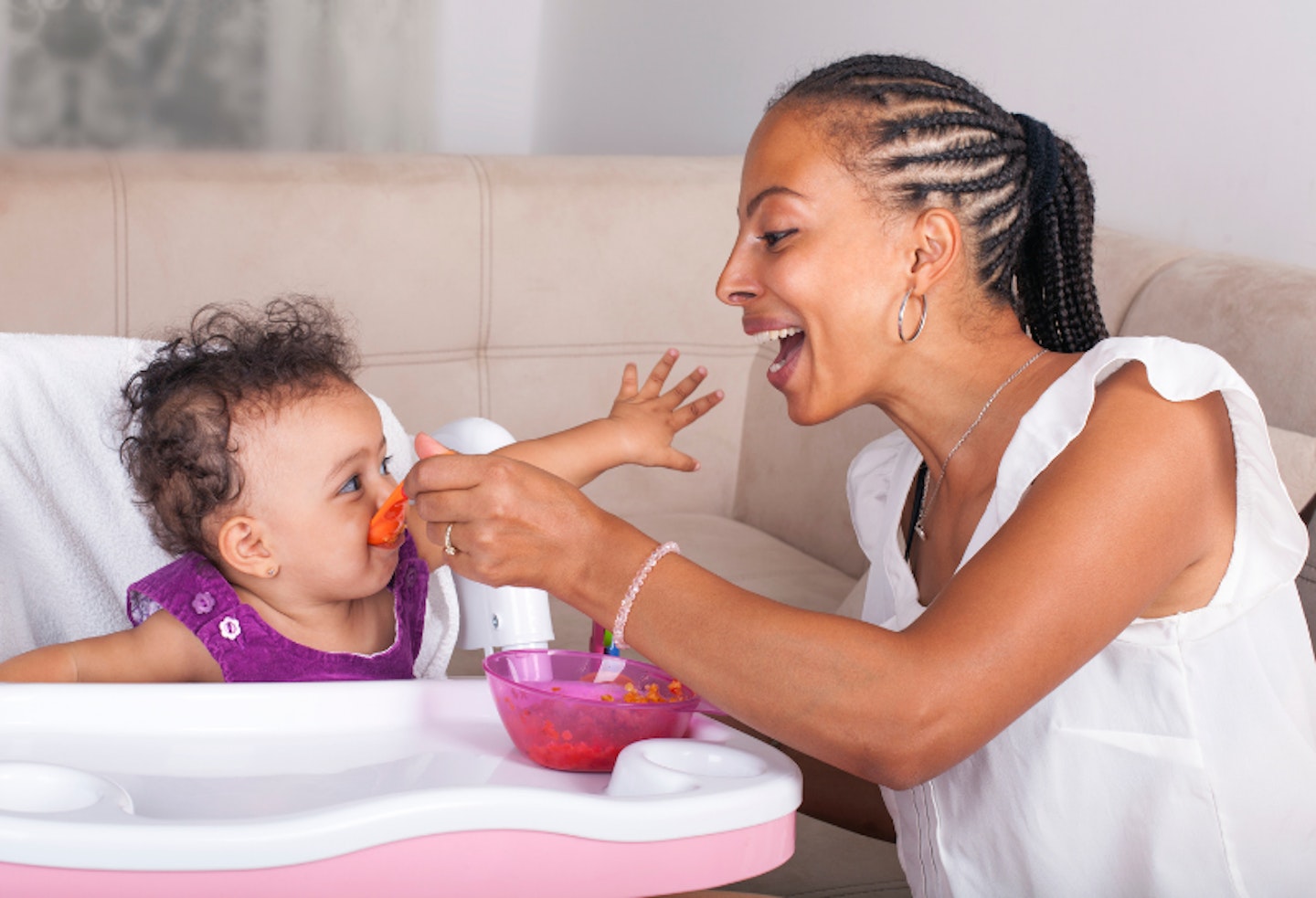Weaning is a huge milestone for you and your baby. It’s the first step on a journey that should see them developing life-long healthy eating habits and positive associations with food.
With a bit of know-how, it can be a fun and exciting experience. So set aside a few days when you can make weaning your main priority. Take it slowly and make sure you have what you need to get started. And have fun watching your little one entering the wonderful world of taste, texture and flavour.
Current NHS advice says weaning should start around six months of age at which point your youngster won’t be able to get all the nutrients they need from milk alone. Some mums do wean earlier than this, but it’s important to know that, until babies are 17 weeks old they should only have milk as their digestive systems simply can’t cope with introducing solid food.
Your baby is ready to wean if…
• They are at least 17 weeks old. If your baby was premature they need to be at least 17 weeks past their due date.
• They can sit up holding their head and chest straight and steady.
• They can coordinate their eyes, hands and mouth, so they can pick things up and put them in their mouth.
• They're interested in food.
• They've lost their tongue-thrust reflex. Tongue-thrusting is when a baby automatically uses their tongue to push something out of their mouth.
• They're relaxed, happy and feeling well.
Getting started
The best time to begin weaning is at lunchtime, after your baby has had half a milk feed, so they're not feeling ravenous. For the first few days, your baby will only manage between one and four teaspoons of food. They’ll want to explore it, so let them smell it, squash it, spit it – whatever they want. It’s all about making eating fun and relaxed. Oh, and don’t wipe their face too much, it makes most babies grumpy! The more relaxed you can be about mess, the easier weaning will be.
Less milk, please!
When your baby starts weaning, they’ll still be having regular milk feeds. That will probably be milk in the morning, mid-morning, at lunchtime, mid-afternoon, and evening. As they eat more, they’ll start dropping these milk feeds – the first one to go is usually their lunchtime milk. By the time they're one, they’ll probably be down to just two milk feeds a day – morning and evening.
Spoon-fed weaning
With liquid food like purée – or with any food that’s been microwaved – it’s important to stir the food if you’re serving it warm. This gets rid of ‘hot pockets’, which might hurt your baby’s mouth. To test the temperature of the purée before you give it to your baby, put a dollop on the inside of your wrist.
Put the bowl of purée on your baby’s tray so they can see what you’re doing. Don’t worry if they stick their fingers in to explore. Take a spoonful of purée and offer it to your baby. The first time you feed them you may have to gently touch their mouth with the spoon. Hopefully, they’ll open up! If they don't, just try again tomorrow. As soon as they get the hang of it, they’ll be opening their mouth up like a baby bird as soon as they see their spoon.
Baby-led weaning
Want to try baby-led weaning? Your baby needs to be sitting securely in their highchair, but able to move their arms and head freely, so they can get at the food.
Give your baby something you’re eating too as baby-led weaning is all about eating together – just make sure it’s age-appropriate and so soft that you could squash it between your thumb and finger to prevent the risk of choking. It will help your baby if you cut the food into finger food - a shape and size that’s easy to grasp. Aim for chip-shaped.
Put the food straight onto your baby’s tray – any bowl will wind up on the floor. Then let them play! If they want to squash, hurl or poke the food, great. They're exploring and, at this stage, that’s exactly what you want them to be doing.
Never leave your baby unattended when he is eating with either method.

How much milk does my baby need?
To start with, your baby is still getting most of their nutrients and energy from either breast milk or infant formula and for the first year of their life, it will be their main drink. If your little one is bottle-fed, they should have 4-5 feeds with a total of 500-600ml of formula milk in 24 hours. If you are breastfeeding, you should continue breastfeeding on demand.
Stick to a routine
Babies like routine – it makes them feel secure. And it’s exactly the same when it comes to food. As well as helping them to build hunger patterns, they quickly get used to expecting food at a particular time of day, so if your baby’s food doesn’t arrive when they're expecting it to, they will get cranky. And that will make the mealtime less fun.
Tips:
• Always check the temperature of the food before you give it to your baby. If it’s a liquid, stir it to get rid of ‘hot spots’.
• If your baby seems reluctant to try a food, try stirring in some of their usual milk, whether formula or expressed breastmilk. This makes the taste more familiar, so they're more likely to tuck in.
When to increase food
By the time your baby’s around five days into their weaning journey, try giving them food at tea time as well as lunchtime. The food at lunch should be a new food, and at tea time, a food they've had before.
Two weeks into their weaning journey, your baby can eat food three times a day, so introduce breakfast, too.
By week three, if you’re only spoon-feeding, you need to introduce food to your baby in tiny lumps so they start getting to grips with texture. These lumps should be so soft that they could squash them between his fingers. Don’t cook a smooth purée with an occasional lump, or your baby will turn their nose up. They're much less likely to fuss if the whole meal has tiny lumps so the texture is consistent – aim for somewhere between puréed and very-well mashed food.
Weaning foods to introduce at six months
Sweet potato
Root vegetables tend to taste sweeter than leaf vegetables, so babies are often keen to eat them. Sweet potatoes are also high in healthy vitamins and fibre.
To prepare it for spoon-feeding:
Preheat your oven to 200°c/gas mark six. Clean the sweet potato and prick it with a fork. Place on a baking tray and roast it for about 45 minutes until it’s soft. Cut the sweet potato in half, scoop out the flesh and purée it in the blender.
To prepare it for baby-led weaning (blw):
Preheat your oven to 200°c/gas mark six. Clean the sweet potato and cut it into chip-shaped pieces. Place on a baking tray and roast for about 20-25 minutes until it’s soft. Cool.
Swede
Swede has got a very mild flavour, so it’s very easy for baby taste buds to get to grips with. It’s full of protective compounds that may help protect against heart disease.
To prepare: peel it, cut it into baby-friendly chunks, then put it in the steamer for 20-25 minutes until it’s very soft. If you’re spoon-feeding, mash it down to the consistency of porridge. If you’re doing blw, simply cool the chunks.
Parsnip
Parsnips are another sweetish root vegetable, packed with fibre, vitamins and potassium – a mineral our organs need to work properly, and very unlikely to provoke an allergic response.
To prepare: preheat your oven to 200°c/gas mark six. Clean the parsnips and chop into quarters, length-ways. Put into a saucepan of water, bring to the boil and simmer for 10 minutes. Drain and shake in a colander, then put into a lightly oiled roasting pan. Roast for about 25 minutes until soft. If you’re spoon-feeding, purée the parsnips (with a little milk if needed). If you’re doing blw, allow it to cool.

Carrot
Babies like the taste of carrots as they’re one of the sweetest of all the vegetables. They’re also easy to digest and a good source of vitamin a.
To prepare: peel and cut it into long, thin sticks, lengthways. Pop in the steamer and steam until it’s soft, roughly 25 minutes. Puree if spoon-feeding, or cool and serve if blw.
Butternut Squash
This vegetable is easy to digest, so it’s gentle on your baby’s still-new digestive system.
To prepare: preheat your oven to 200°c/gas mark six. Peel the squash and cut it into big chunks. Roast it for 30-35 minutes. If spoon-feeding, mash it up to the consistency you want and cool, otherwise simply allow to cool.
Avocado
Avocado contains more nutrients than any other fruit, it’s easy to digest and babies usually really like its creamy texture.
To prepare: if you’re spoon-feeding, just peel it, get rid of the stone and blend the fruit into a simple guacamole-green purée. If you’re baby-led weaning, peel, de-stone and cut into manageable chunks.
Banana
Bananas are sweet, nutritious and a good source of the mineral potassium.
To prepare: iI you’re baby-led weaning, partially un-peel the banana so the top part of the fruit is poking out. If you’re spoon-feeding, mash to the consistency you want.
Pear
Pears are very easy on little digestive systems. They’re full of water, so they help protect against constipation and are a good source of vitamin c.
To prepare: Wash and peel, chop it into chunks and steam it until it’s soft. If you’re spoon-feeding, blend into a purée. If you’re baby-led weaning, simply cool.
